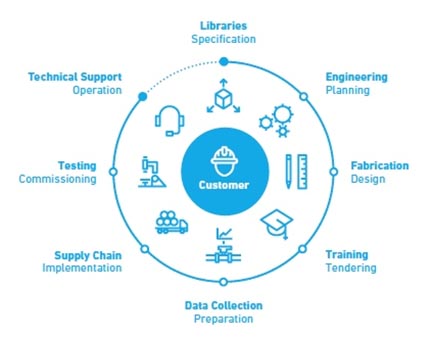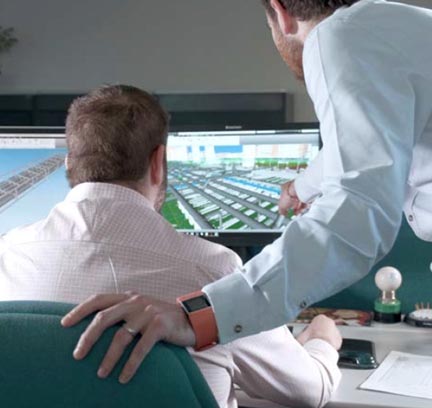Maximizing The Benefits Of Plastic Pipe Prefabrication And Engineering
Thermoplastic piping’s advantages are not limited to chemical-resistant properties alone. Before the first component is installed, plastic pipe engineering principles and prefabrication options create multiple cost and performance benefits. Water Online spoke with Brian LaBelle of GF Piping Systems to understand how water treatment facilities and OEMs can take greater advantage of the full breadth of plastic piping’s opportunities.
What do offsite prefabrication and engineering support involve?
Offsite prefabrication is a strategic approach to plastic piping systems that combines the knowledge of a specialty subcontractor, the economic and scheduling advantages of production line assembly, and control of the entire process without the disruptions of a construction site.
Engineering support can range from consultation on the requirements of plastic piping construction and performance to full design collaboration, review and analysis. It can be provided as part of a total prefabrication solution or accessed as a contract service by water utilities and other industries, OEMs, and consulting engineering firms to help users maximize plastic piping benefits (Figure 1).

Graphic courtesy of GF Piping Systems
Figure 1. Working closely with plastic piping system suppliers who can provide support throughout the entire construction project timeline enables design engineers and their clients to maximize the benefits of plastic piping systems for optimal long term performance and reliability.
How is offsite prefabrication beneficial as a construction strategy?
According to this Dodge Data & Analytics study, prefabricated assemblies offer multiple advantages related to productivity, quality scheduling, and cost predictability. With the consistent craftsmanship of trained and certified technicians specializing in plastic piping design and fabrication, a dedicated ISO 9001-compliant prefabrication facility can relieve the risk of using a less-experienced onsite workforce even when pushing the envelope of design sophistication and fabrication complexity. Best of all, it can aid in rapid onsite installation as soon as prep work at the construction site has been completed.
What are the advantages to be realized by offsite prefabrication?
The greater the risks to the construction process — e.g., availability of skilled labor, piping complexity, a high number of joints, space constraints on construction sites, unfavorable environmental conditions, liability for scheduling delays, etc. — the greater the benefits of offsite prefabrication. The most obvious benefits revolve around control over cost and timing but can touch on all aspects of implementation. Prefabrication provides advantages of instant access to specialized equipment and qualified installers, , a clean production environment, and control over quality and scheduling that can be difficult to maintain in an onsite construction environment.
What do water utilities and their contract engineering firms need to understand about prefabricated piping subsystems that is different from traditional piecemeal construction?
One aspect that differentiates the cost and logistical advantages of plastic piping prefabrication is how big a role preplanning and interdisciplinary collaboration play in maximizing the payback potential. Those considerations range from high-end concerns of how best to organize the overall design from easy-to-ship-and-assemble spool pieces and headers all the way down to details of what are the entryway clearances for getting those subassemblies into the building and the final application space.
Design-build firms are particularly well positioned to take advantage of that type of approach. But even more conventional construction practices relying on separate design and construction bids can harness the advantages, provided that the end-use customer is committed to early coordination and communication and to the financing timeline that goes with it.
What’s the first step toward leveraging thermoplastic pipe engineering and prefabrication services?
Before designing or physically constructing components or subassemblies, it is important to start with a discussion that formalizes the goals of the project and the physical and business benefits of prefabrication to get all parties on the same page. This includes understanding differences in design and implementation principles between plastic and metal piping systems, evaluating if prefabrication is a good fit, identifying potential challenges, and coming to agreement on acceptable outcomes and scheduling.
What should decision-makers look for when selecting an offsite prefabrication partner?
Whether a consulting engineer is looking to maximize the capabilities of plastic piping design, a contractor or design-build firm is looking to sharpen its bidding process, or a water treatment utility is looking to accelerate project build-out, here are some of the capabilities to look for in a total-solution offsite prefabrication partner:
- Planning/Support Resources. Even where process designs will be provided to the prefabricator, innovative disciplines such as 3D CAD, BIM modeling, lean practices, and integrated project delivery (IPD) methodologies can help streamline and improve implementation (Figure 2). A knowledgeable prefabrication partner can also double-check hydraulic calculations, support bracket spacing, buried pipe influences, and regulatory code compliance to avoid rebuilds.

Photo courtesy of GF Piping Systems
Figure 2. Using the computer-aided design and analytical resources of a plastic piping prefabrication specialist can help any design engineer, contractor, or water utility reap the benefits of experience in plastic piping disciplines without having to invest in new personnel or software.
- Compatible Materials. Using prefabrication services provided by a manufacturer of plastic piping systems will help to ensure that all components are readily available in the materials demanded by the design — PVC, CPVC, ABS, PE, PP, PVDF, ECTFE, etc. That should include all plastic pipe and fittings, manual valves, actuated valves, sensors, instrumentation to be integrated as part of the piping system, and, in some cases, pumps, tanks, and pipe support framing as well.
- Assembly Capabilities. As designs become more sophisticated — i.e., complex or tightly spaced headers, more sophisticated sensors, automated controls, etc. — or as more advanced piping materials are required, look for suppliers who can support them with appropriate fabrication and heat fusion technologies. These can include state-of-the-art joining capabilities such as segmented fittings, conventional butt-and-socket fusion, infrared butt-fusion, bead- and crevice-free fusion, electrofusion, and hot-gas welding for complex geometries, as well as solvent cementing for a variety of plastic piping materials.
- Analysis And Testing. Pressure testing is certainly expected as a minimum quality control check. Depending on the nature of the application, however, look for the ability to conduct other appropriate evaluations. These can range from finite element analysis to static evidence testing, dynamic mechanical stress analysis, heat loss calculations, seismic calculations, water hammer avoidance, and more.
In which types of applications has prefabrication of thermoplastic piping proven its value?
Prefabricated plastic piping systems are used across a wide range of applications where chemical resistance, weight, installation time, and installation costs can make a difference. These include semiconductor manufacturing, municipal & industrial water and wastewater treatment, gas and water utilities, life sciences, data centers, shipbuilding, and skid-mounted OEM system applications where size, scope, complexity, or construction delays have presented major concerns about conventional onsite builds.
Are there size limitations or minimum-size projects for piping prefabrication strategies?
No, piping system prefabrication is scalable to any size of project — large or small.
 Brian LaBelle is Director of Business Development, Water Treatment & Energy for GF Piping Systems Americas, manufacturer of piping systems for the conveyance, measurement and control of gas and liquids in a wide variety of industrial, municipal and commercial applications. Mr. LaBelle is Vice-Chair of the AWWA Standards Committee for Online Monitoring, served two terms as Director-at-Large for the Measurement Control and Automation Association, is a published author and frequent speaker/presenter at major industry conferences, and has visited hundreds of water & wastewater treatment facilities and power plants around the world in a career that has so far spanned more than 30 years. Brian is also a magna graduate of California State Polytechnic University, Pomona and served 11 years in the US Naval Reserve.
Brian LaBelle is Director of Business Development, Water Treatment & Energy for GF Piping Systems Americas, manufacturer of piping systems for the conveyance, measurement and control of gas and liquids in a wide variety of industrial, municipal and commercial applications. Mr. LaBelle is Vice-Chair of the AWWA Standards Committee for Online Monitoring, served two terms as Director-at-Large for the Measurement Control and Automation Association, is a published author and frequent speaker/presenter at major industry conferences, and has visited hundreds of water & wastewater treatment facilities and power plants around the world in a career that has so far spanned more than 30 years. Brian is also a magna graduate of California State Polytechnic University, Pomona and served 11 years in the US Naval Reserve.
